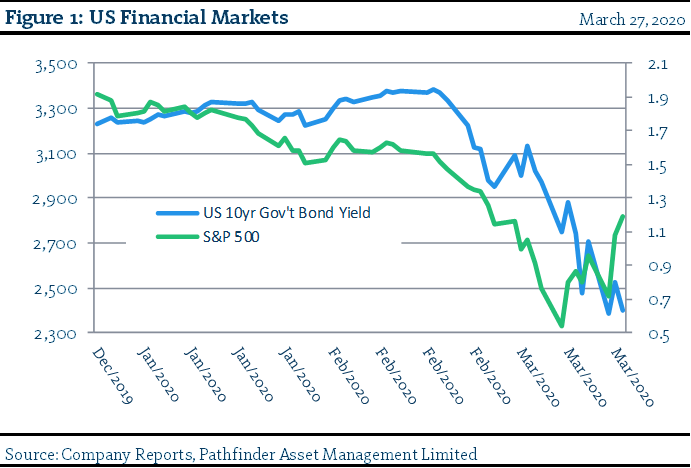Stock Price Volatility Continues
In last week’s note, we wrote about the definition of a bear market, which is defined as a top to bottom return of -20% from a market high. North American markets had fallen past -34% and we noted how fast this change had occurred. On average, the drop took 149 days to reach -20% and this time it took only 19 days.
What shocked most investors this week (including us) was a rally back from the recent bottom, set on March 23rd, 2020 up through 20%, which is the technical definition of a bull market. We do not believe that most investors have concluded that this situation has been resolved and we are now “getting back to normal”. The recent price action of the stock market defines classic signs of volatility. Vol (as we call it on the trade desk) is price movement, both up and down. The fear and panic that investors recently exhibited is the manifestation of downside volatility, while the relief that was felt this week from the rally is still volatility, it’s just upside volatility. In either case, these feelings and the price action is created by uncertainty. As an investor, it is very important not to let emotions overpower logic.
- We present year-to-date equity and fixed income market performance, again this week, in Figure 1 below. Please note that stock markets bounced back (green line) while the fixed income market has not (blue line).
- There were a few “first in my career” data points this week that have contributed to the uncertainty: 3.2 million jobs lost in one week (4.5 times 1982’s previous record), and a US$2.2 Trillion rescue package. I believe unfortunately, there are more of these types of data points to come.
- It appears that the United States has a serious issue with COVID-19 and that efforts to avoid significant impacts to the US economy (and Canada’s by linkage) will fail. I suspect that the data will get worse before it gets better.

“This means that” while we continue to remain concerned about the human cost of COVID-19 and now believe that we are in a global recession, we also remain focused on our investment process. Our various mandates have been active, some have added new companies at recent lows and others have raised more cash into the recent rally. Again, I would like to reiterate that it is important to maintain a long-term perspective. Being prepared and level-headed will hopefully allow us to position our portfolios with excellent quality companies over the coming months.
National Instrument 31-103 requires registered firms to disclose information that a reasonable investor would expect to know, including any material conflicts with the firm or its representatives. Doug Johnson and/or Pathfinder Asset Management Limited are an insider of companies periodically mentioned in this report. Please visit www.paml.ca for full disclosures.
*All returns are time weighted and net of investment management fees. Returns from the Pathfinder Partners’ Fund and Pathfinder Real Fund are presented based on the masters series of each fund. The Pathfinder North American Equity Portfolio and The Pathfinder North American Income Portfolio are live accounts. These are actual accounts owned by the Pathfinder Chairman (Equity) and client (High Income) which contain no legacy positions, cash flows or other Pathfinder investment mandates or products. Monthly inception dates for each fund and portfolio are as follows: Pathfinder North American Equity Portfolio (January 2011), Pathfinder North American High-Income Portfolio (October 2012) Pathfinder Partners’ Fund (April 2011), Pathfinder Real Fund (April, 2013), and Pathfinder International Fund (November 2014).
Pathfinder Asset Management Limited (PAML) and its affiliates may collectively beneficially own in excess of 10% of one or more classes of the issued and outstanding equity securities mentioned in this newsletter. This publication is intended only to convey information. It is not to be construed as an investment guide or as an offer or solicitation of an offer to buy or sell any of the securities mentioned in it. The author has taken all usual and reasonable precautions to determine that the information contained in this publication has been obtained from sources believed to be reliable and that the procedures used to summarize and analyze such information are based on approved practices and principles in the investment industry. However, the market forces underlying investment value are subject to sudden and dramatic changes and data availability varies from one moment to the next. Consequently, neither the author nor PAML can make any warranty as to the accuracy or completeness of information, analysis or views contained in this publication or their usefulness or suitability in any particular circumstance. You should not undertake any investment or portfolio assessment or other transaction on the basis of this publication, but should first consult your portfolio manager, who can assess all relevant particulars of any proposed investment or transaction. PAML and the author accept no liability of any kind whatsoever or any damages or losses incurred by you as a result of reliance upon or use of this publication.